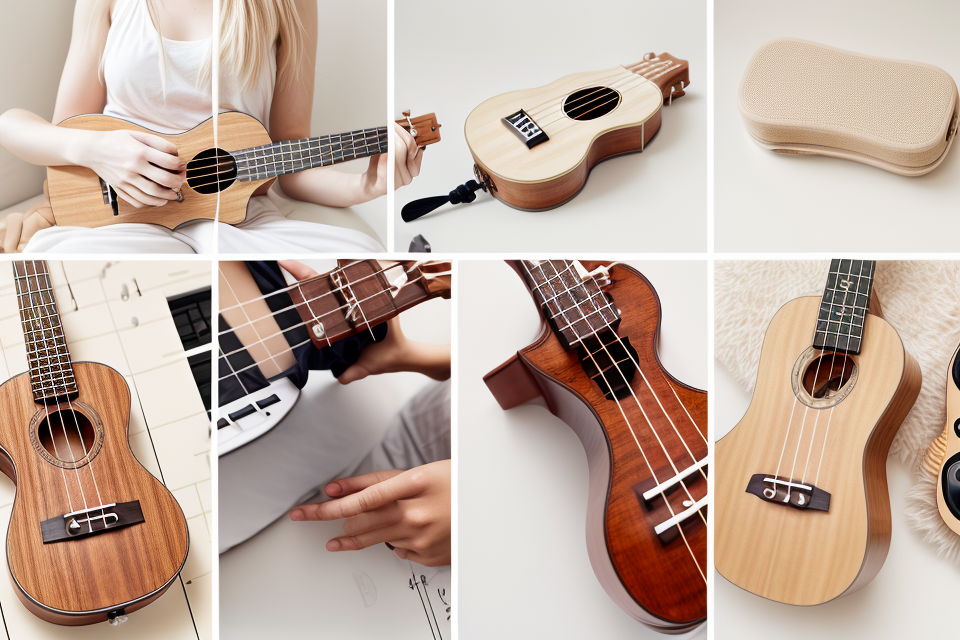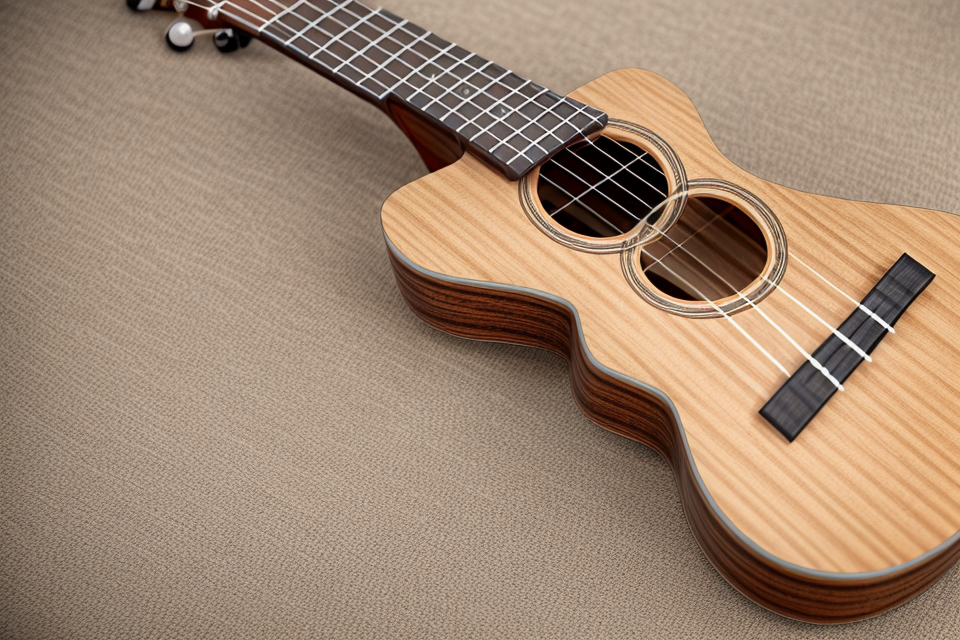Have you ever wondered which instrument is easier to learn between the piano and the ukulele? Both instruments have their own unique charm and are popular among musicians of all ages. But when it comes to learning, which one is the better choice? In this article, we will explore the differences between the two instruments and compare their ease of learning. From the physical aspects of playing to the complexity of the music, we will dive into what makes each instrument unique and which one might be the perfect fit for you. So, grab your instrument of choice and let’s get started on this comprehensive comparison!
Understanding the Instruments
Key Features of a Piano
- The keyboard layout
The keyboard layout of a piano is a pattern of black and white keys arranged in a grid-like formation. The layout consists of seven octaves plus a minor third, with the black keys in groups of two and three. The white keys are represented by the natural notes A through G, while the black keys represent the sharps and flats. The pattern of the keyboard is designed to allow for a wide range of notes to be played, from the deepest bass notes to the highest treble notes. - The action of the keys
The action of the keys refers to the mechanism inside the piano that causes the keys to produce sound when pressed. The action is responsible for transmitting the force of the player’s keystroke to the strings, and it determines the feel and responsiveness of the instrument. In a grand piano, the action is located beneath the keys and is connected to the keyswitch, which is activated when the key is pressed. In an upright piano, the action is located vertically, and the keys are connected to the keyswitch by a system of levers and rods. - The pedals
The pedals of a piano are used to control the sound of the instrument and provide various effects. The most commonly used pedals are the sustain pedal, the soft pedal, and the sostenuto pedal. The sustain pedal is used to sustain the notes that are being played, allowing them to ring out for longer periods of time. The soft pedal is used to mute the sound of the strings, creating a softer, more delicate sound. The sostenuto pedal is used to sustain a single note or a small group of notes, allowing the player to hold them for longer periods of time without the need to continually press the sustain pedal. Other pedals, such as the una corda pedal and the practice pedal, may also be found on some pianos and serve specific functions.
Key Features of a Ukulele
- The Four Strings
- Each string is typically made of nylon or fluorocarbon, giving the instrument a unique tonal quality.
- The strings are stretched over a fretboard, which is smaller than that of a guitar, allowing for easier reach and manipulation.
- The Small Body Size
- The ukulele’s compact size contributes to its accessibility for players of all ages and skill levels.
- Its size also allows for more comfortable playing posture, reducing the risk of physical strain.
- The Tuning Pegs
- The tuning pegs on a ukulele are located on the headstock and are used to adjust the tension of the strings.
- They allow for easy tuning and maintenance, ensuring that the instrument stays in tune for extended periods.
- Some modern ukuleles come equipped with geared tuners, which offer a more precise and efficient tuning experience.
Physical Aspects of Learning
Posture and Hand Positioning
When it comes to posture and hand positioning, both the ukulele and piano require proper technique to avoid injury and maximize playing ability.
Piano
Playing the piano requires the hands to be positioned on the keys at all times. This means that the fingers must be curved and relaxed, with the thumb positioned in a natural way that allows for fluid movement between keys. The hands must also be positioned in a way that allows for proper finger placement for chords and melodies.
Proper hand positioning is essential for playing the piano, as it can have a significant impact on the sound quality and ease of playing. If the hands are not positioned correctly, it can lead to discomfort and injury, and make it difficult to play with accuracy and expression.
Ukulele
Playing the ukulele also requires proper hand positioning, but in a different way. The hands must be positioned on the fretboard and strings, with the fingers curved and relaxed. The thumb should be positioned in a way that allows for proper finger placement for chords and strumming.
Unlike the piano, the ukulele is played with the fingers and thumb of the fretting hand, rather than the full hand. This means that the fingers must be positioned in a way that allows for proper finger placement on the fretboard, while the thumb is used to fret the strings.
Proper hand positioning is crucial for playing the ukulele, as it can affect the sound quality and ease of playing. If the hands are not positioned correctly, it can lead to discomfort and injury, and make it difficult to play with accuracy and expression.
In conclusion, both the ukulele and piano require proper hand positioning for proper playing technique. While the hands are positioned differently for each instrument, the principles of proper finger placement and relaxation remain the same. Proper hand positioning is essential for playing both instruments with accuracy, expression, and without injury.
Accessibility and Space Requirements
When it comes to accessibility and space requirements, the piano is an instrument that requires more space than the ukulele. It is a large instrument that is typically heavier and bulkier than the ukulele, which makes it difficult to move around or transport. In order to play the piano, you will need a dedicated piano or a space with enough room to accommodate the instrument.
Additionally, the piano is an expensive instrument to purchase and maintain. It requires regular tuning, which can be costly, and it also requires a certain level of space to produce a good sound. As a result, many people may find it difficult to access a piano or to afford the cost of owning one.
In contrast, the ukulele is a small and portable instrument that can be played in a smaller space. It is a lightweight instrument that is easy to move around and transport, which makes it an ideal choice for people who want to learn an instrument but do not have a lot of space or money to invest in a piano.
Moreover, the ukulele is a relatively inexpensive instrument to purchase and maintain. It does not require regular tuning like the piano, and it is less expensive to purchase than a piano. As a result, many people find it easier to access and learn the ukulele than the piano.
Overall, the physical aspects of learning the ukulele or piano can have a significant impact on the learning process. While the piano may be a more complex and challenging instrument to learn, it can also be more expensive and difficult to access. On the other hand, the ukulele is a small and portable instrument that is easier to access and learn, making it a popular choice for beginners.
Time Commitment
When it comes to the time commitment required for learning the ukulele or piano, there are some notable differences between the two instruments.
Piano lessons typically require longer practice sessions in order to master the instrument. This is because the piano has a wider range of notes and a more complex keyboard layout, which can make it more challenging to learn. Additionally, more complex pieces often require more time to learn, as they involve intricate melodies, harmonies, and rhythms.
However, the benefits of longer practice sessions are that pianists can make more significant progress in a shorter amount of time. With consistent effort and dedication, even beginners can learn to play basic songs within a few months. Furthermore, the piano’s wide range of notes and versatile sound make it a popular choice for a variety of musical genres, from classical to pop.
In contrast, learning the ukulele often requires shorter practice sessions to yield progress. This is because the ukulele has a smaller range of notes and a simpler fretboard layout, which makes it easier to learn basic chords and strumming patterns. Furthermore, the ukulele’s small size and lightweight construction make it a highly portable instrument, which allows players to practice anytime, anywhere.
However, the benefits of shorter practice sessions are that ukulele players can enjoy a sense of accomplishment more quickly. Even beginners can learn to play basic songs within a few weeks, which can be a great motivator to continue learning. Additionally, the ukulele’s light and cheerful sound make it a popular choice for a variety of musical genres, from traditional Hawaiian music to modern pop.
Overall, the time commitment required for learning the ukulele or piano depends on individual preferences and goals. However, both instruments offer unique benefits and challenges, and with dedication and practice, anyone can learn to play beautiful music.
Skill Development
Scales and Arpeggios
Piano
- Mastery of scales and arpeggios is crucial for advanced playing
- Scales are a series of single notes played in ascending or descending order, while arpeggios are a series of notes played in a descending order.
- Practicing scales and arpeggios helps to develop finger dexterity and muscle memory, which is essential for playing more complex pieces.
- Scales and arpeggios also help to develop a solid foundation in music theory, which is crucial for understanding the structure of music.
Ukulele
- Basic understanding of scales and arpeggios
- Scales and arpeggios are also important for ukulele players, although the technique is slightly different.
- The ukulele has four strings, which means that scales and arpeggios are played using a combination of fingers.
- Practicing scales and arpeggios on the ukulele helps to develop basic finger dexterity and coordination, which is essential for playing more complex pieces.
- However, unlike the piano, the ukulele does not require a mastery of scales and arpeggios for advanced playing.
Music Theory
When it comes to music theory, the piano and ukulele differ in the complexity of the concepts required for advanced playing.
For the piano, advanced playing requires a deeper understanding of complex music theory. This includes a comprehensive knowledge of key signatures, chord progressions, and rhythm. As a result, the piano’s music theory can be more challenging to learn than the ukulele’s.
In contrast, the ukulele’s music theory is simpler. While still requiring a basic understanding of chords and strumming patterns, the ukulele does not require the same level of mastery over complex concepts as the piano. This can make it a more accessible instrument for beginners looking to learn music theory.
Overall, the level of music theory required for advanced playing on the piano is generally higher than that of the ukulele. However, this does not mean that the ukulele is inherently easier to learn. Both instruments have their own unique challenges and rewards, and the choice between them ultimately depends on personal preference and musical goals.
Improvisation and Composition
Improvisation and composition on the piano involve a higher level of complexity due to the instrument’s wider range of notes and more intricate mechanics. Players must have a deep understanding of music theory, including chord progressions, scales, and harmonies, to create intricate pieces. The piano’s keys and pedals provide a vast array of sound possibilities, enabling advanced players to explore various musical styles and genres.
In contrast, the ukulele offers simpler improvisation and composition techniques, making it an excellent choice for beginners. Players primarily rely on basic chord progressions and strumming patterns to create simple melodies and songs. While some understanding of music theory is beneficial, it is not as crucial as on the piano. The ukulele’s four strings and limited fretboard require players to focus on basic chord structures and rhythms, encouraging creativity within these constraints.
While the piano may offer more advanced improvisation and composition techniques, the ukulele’s simplicity can also be an advantage. The instrument’s compact size and portability make it easy to take anywhere, and its simpler mechanics allow beginners to focus on developing essential skills like strumming, chord transitions, and basic melodies.
Ultimately, the choice between learning the ukulele or piano depends on individual preferences and goals. Both instruments offer unique challenges and opportunities for skill development, and the decision should be based on personal interests, musical aspirations, and available resources.
FAQs
1. What are the main differences between learning to play the piano and the ukulele?
The piano and the ukulele are both stringed instruments, but they have some key differences that affect how they are played and learned. The piano has a more complex layout with 88 keys and multiple octaves, while the ukulele has only four strings and a smaller size. The piano also requires more dexterity to play, as both hands must be used to play separate keys at the same time. On the other hand, the ukulele is played with a single hand, which may make it easier for beginners to learn.
2. How long does it take to learn to play the piano versus the ukulele?
The amount of time it takes to learn to play either the piano or the ukulele depends on the individual and how much time they dedicate to practicing. However, the ukulele is generally considered to be easier to learn in the beginning, as it has fewer strings and a simpler layout. A person may be able to learn basic chords and simple songs on the ukulele in just a few weeks, while it may take several months or even years to become proficient on the piano.
3. What are the benefits of learning to play the piano versus the ukulele?
Both the piano and the ukulele have their own unique benefits. The piano is a versatile instrument that can be used to play a wide range of music, from classical to modern pop. Learning to play the piano can also improve a person’s dexterity and hand-eye coordination. The ukulele, on the other hand, is a great instrument for beginners, as it is relatively easy to learn and can be played in a variety of styles, including folk and rock. The ukulele is also a great choice for those who want to play music in a more relaxed, laid-back style.
4. Is one instrument better than the other for beginners?
In general, the ukulele is considered to be a better choice for beginners than the piano. This is because the ukulele is easier to learn, with a simpler layout and fewer strings. The ukulele is also a more affordable instrument, making it a great choice for those who are on a budget. However, ultimately the choice between the piano and the ukulele will depend on the individual’s personal preferences and goals. Some people may find that they have a natural talent for the piano, while others may prefer the more laid-back style of the ukulele.



